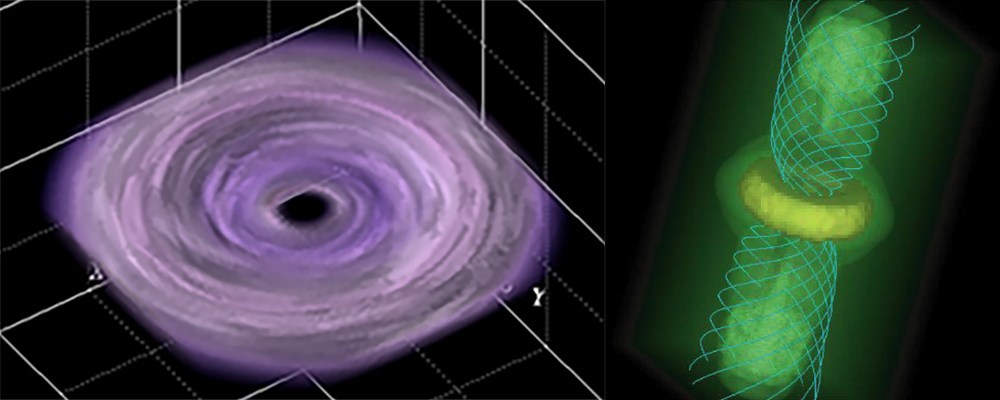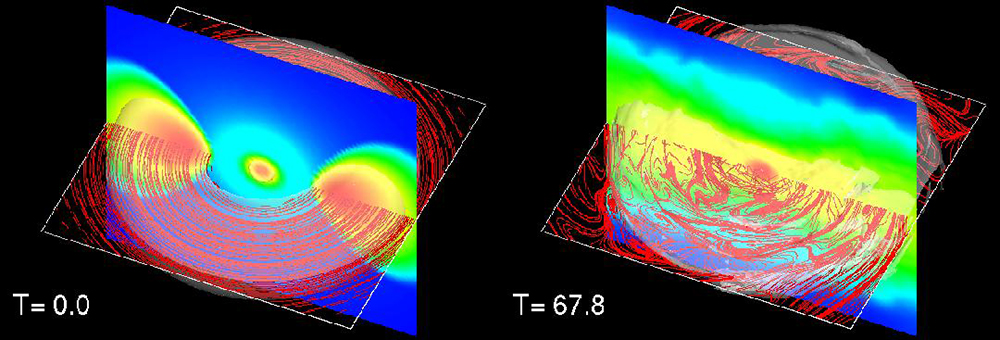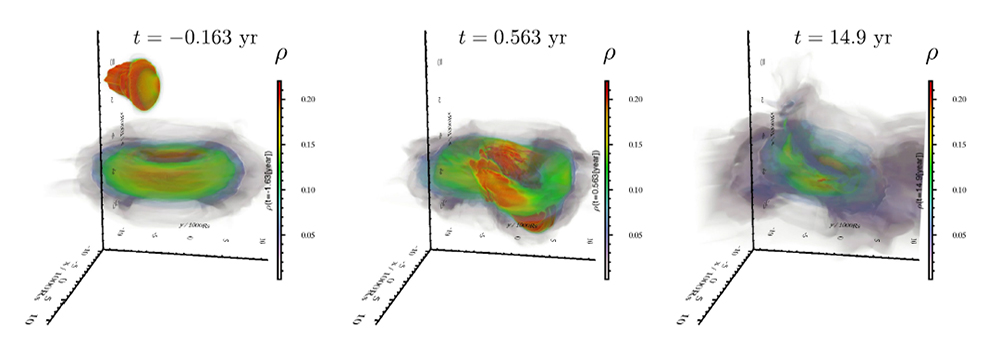Professor
Division of Plasma Astrophysics

Accretion disks form around gravitating objects (see Fig.1), and they are thought to drive a variety of active phenomena (i.e. extreme time variations, X-ray emission, astrophysical jets, etc.) observed near the cores of active galactic nuclei and black hole candidates in galaxies. The source of the required energy to produce those phenomena is the gravitational energy of matter revolving around and falling towards the central object. Without friction, matter revolving around a central object will continue to do so. In that case, no energy is extracted. However, if friction acts on that matter, it loses angular momentum and falls toward the central object and enters an inner orbit (see Fig.2 left). The difference in gravitational energy between those two orbits (see Fig. 2 right) is the source of energy for the accretion disk. If the central body is a black hole, this mechanism extracts between 5% and 40% of the matter’s rest energy. This is orders of magnitude more efficient than nuclear fusion. That is why black hole accretion disks are the brightest objects in the observable universe.

The Plasma Astrophysics Division at ICEHAP investigates accretion disk formation, time variation, and jet formation mechanisms using magnetohydrodynamic simulations. High-temperature plasmas like those found in black hole accretion disks have low viscosity, and what we observe cannot be explained by angular momentum loss due to fluid viscosity. On the other hand, there is sufficient angular momentum transport when magnetic fields are brought into consideration. Figure 3 shows the result of magnetohydrodynamic simulation considering interactions between a magnetic field and a plasma. The left image in Figure 3 shows a 3D magnetohydrodynamic simulation in a rotating torus with a weak toroidal magnetic field (red lines). From the initial conditions, magnetic turbulence developed as shown in the right image, with angular momentum transported by magnetic stress causing the revolving matter to fall, such that after ten rotations, a disk-like accretion flow was formed. The magnetic field is strengthened within the disk and rises to the surface. This field is distorted due to the rotation of the disk, and a jet like that shown in the right-hand image of Figure 1 is formed.

The interaction between radiation and matter becomes important when black hole candidates inside galaxies and in the bright cores of active galaxies such as quasars and Seyfert galaxies brighten. The Plasma Astrophysics Division conducts radiation-magnetohydrodynamic simulations of black hole accretion flows during brightening using the higher-order accuracy 3D magnetohydrodynamic code called CANS+, which was developed by our group and CANS+R, which is a radiation-magnetohydrodynamic code that integrates radiative transport code based on the M1-closure approximation. (See Figure 4.) Our calculations show that jets intermittently erupt from the vicinity of black holes at the center of accretion disks. In addition, in Seyfert galaxies with black holes around 10 million times the mass of the Sun, we discovered that soft X-ray emitting regions are formed during bright periods, and quasi-periodic oscillations are generated within those regions. By comparing monitoring observations of active galactic nuclei (AGN) in both the X-ray and visible light bands, we get closer to understanding the mechanism of time variation and jets in AGN engines in source candidates for high-energy neutrinos.
The Plasma Astrophysics Division is also engaged in researching the area around the core of our own galaxy. In the center of the Milky Way, there is a black hole four million times more massive than our Sun. In 2013, a gas cloud approached that black hole. Figure 5 shows a simulation of that event. The simulation showed that when the gas cloud approaches the accretion disk from the upper left and passes through it, it passes on some of its momentum, whereupon the accretion disks axis tilts. Around ten years after the passage of the cloud, the magnetic field has become stronger, and the accretion disk becomes more active. It is possible that the galactic core will become brighter in the 2020s. If it were a star rather than a gas cloud that was torn apart by the gravity of the black hole as it gets closer, the center of the Milky Way could become as bright as the most luminous blazar. We have conducted simulations of events like those as well.
